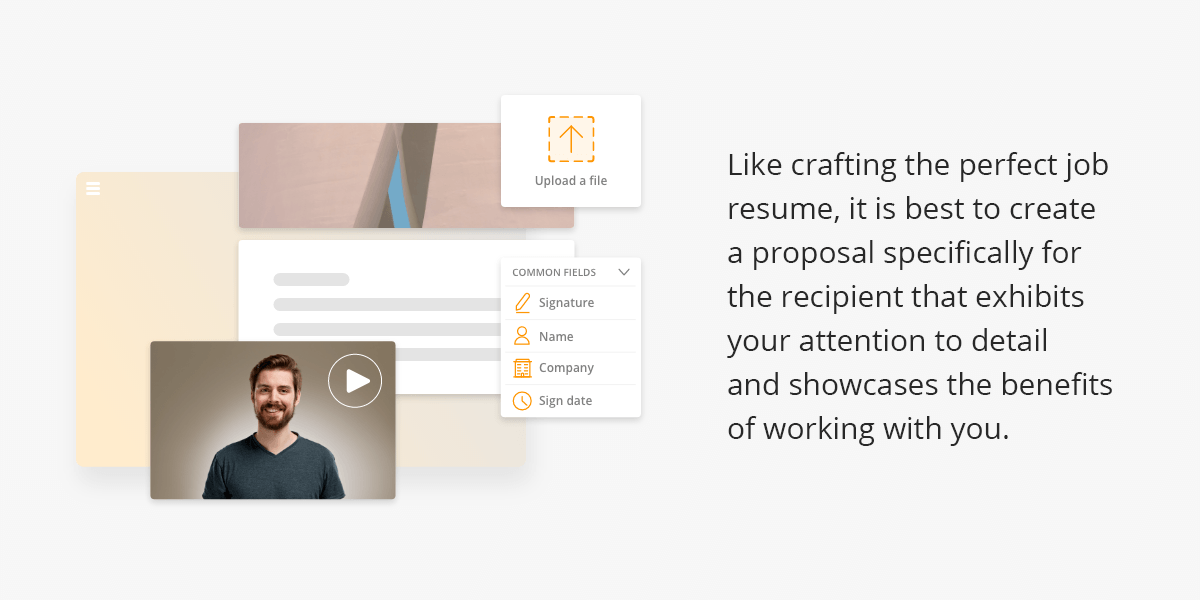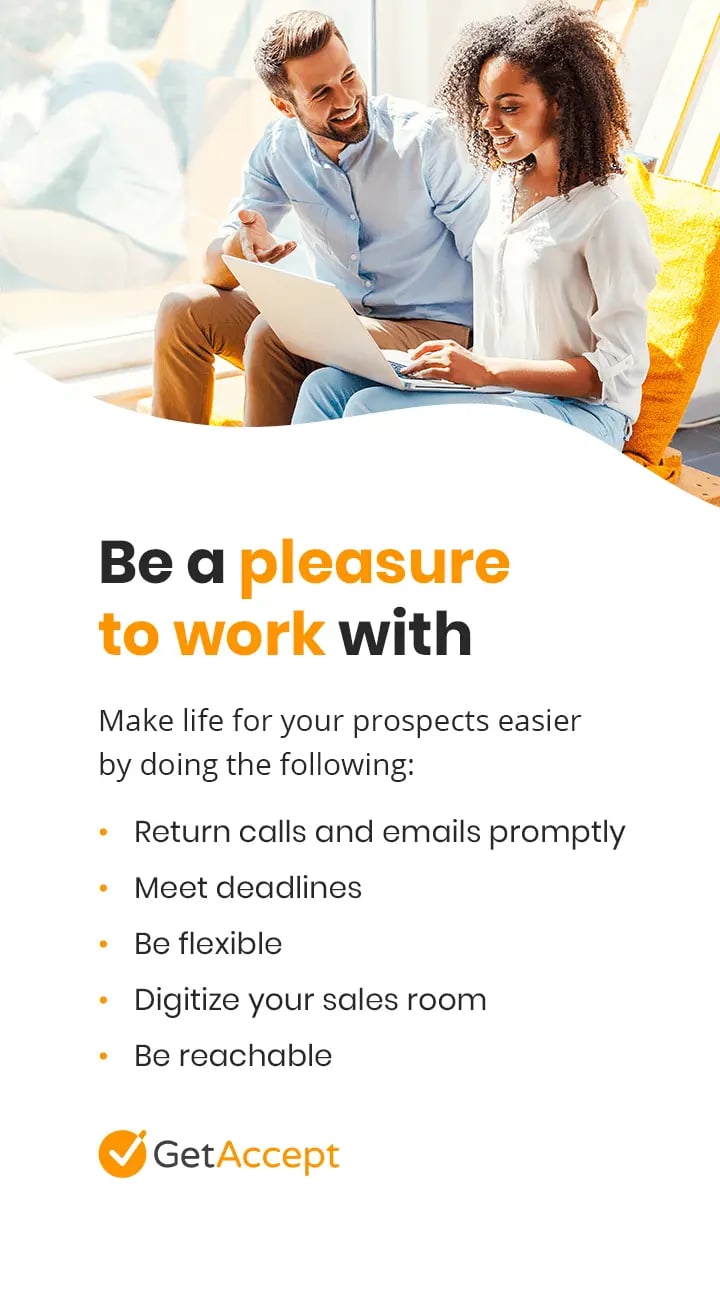For those who work in sales, time is money. Every step matters in the sales funnel, from first impressions to signing the final documents. Your close rate allows you to identify how effective your proposals are and where you could use improvement.
There are some best practices for locking in clients and giving them the most satisfying experience with your business. Today, creating a seamless collaboration process and digitizing your deals will transform how you interact with your customers.
With a digital sales room, closing deals becomes a flexible and streamlined process that changes how you approach new ventures and makes signing off on new agreements easier. Whether you're a sales coach or a new Account Executive, here are 18 tips for closing more deals and becoming a better seller.
1. Establish relationships
There is more to businesses than making the most money. Harnessing a customer base requires a great deal of relationship building. You want your customers to keep coming back time after time and refer your services to their friends and family members. To acquire loyal clientele, you must consider an impending deal as a burgeoning relationship.
Establishing meaningful connections is the best way to make moves toward closing deals. When working with someone new, it is best to try and understand their needs and wants upfront.
Anticipate your client's future worries and questions as a way of expressing how much you genuinely care about their success. Listen attentively during conversations and keep detailed accounts. You can use insights to offer your clients a customized experience with your business. Be willing to compromise and negotiate, exhibiting how much you value working with them before worrying about closing the deal.
Customer relationship management (CRM) software such as Salesforce and HubSpot can help you use customer information to understand your buyers and their journeys.
2. Focus on sales engagement
Sales engagement is an important aspect of closing deals in a digital sales room. Understanding how your prospective customers communicate with your business and interact with your proposals means having valuable insights into the productivity and effectiveness of your sales approach.
The following are examples of measurable interactions that contribute to sales engagement:
- The length of time a prospect spends on viewing your proposal
- Any actions the prospect takes with your proposal, like forwarding or printing it
- Whether or not your prospect watched the introductory proposal material
- How many people within your prospective client's organization have reviewed the proposal
Learn more about increasing sales engagement by reading GetAccept's ultimate sales engagement guide.

3. Customize every proposal
Like crafting the perfect job resume, it is best to create a proposal specifically for the recipient that exhibits your attention to detail and showcases the benefits of working with you.
From the discovery call to a quick email sent by the prospect, there are plenty of opportunities to gather all the necessary information you retrieved throughout the sales process.
Ask yourself the following questions before crafting your personalized proposal:
- Who is in charge of making relevant decisions within the prospect's organization?
- What are the prospect's goals?
- Is there a defined budget?
- What is the prospect's desired timeline?
- Is your prospect considering your competitors to get the job done?
Use the answers to these questions to exhibit how much you value the prospect's business within your customized proposal.
4. Forecast as best as you can
Once again, time is money in the business of sales. It is best to spend time on deals that are more likely to close successfully. But how do you differentiate between interested prospects and those who aren't ready for the next step? The answer is timed engagement.
Use your understanding of sales engagement and how prospects interact with your business to narrow down your list of potential customers. Disqualifying indifferent or unengaged prospects allows you to focus your energies on more promising leads. Forecasting the actions of your prospective clients gives you the tools to make better business decisions.
5. Have an organized plan
Having a clear agenda is an invaluable tool for people working in sales. You should have an organized account of where all of your prospects are in the sales funnel. This allows you to identify and prioritize the most promising leads and distribute your attention accordingly.
At the beginning of any sales relationship, it is helpful to learn the prospect's desired timeline and how you can accommodate it. Setting a clear itinerary and goals for each meeting or call is also good to keep the sales process on track. This allows everyone involved access to a transparent agenda that keeps everyone on the same page.
6. Address common objections early
Objections are a natural part of the sales process. Some prospects will offer reasons they are not interested or ready to close a deal with your business.
Getting ahead of these objections and addressing them early in the sales process allows you to gauge whether or not you can persuade the prospect or accommodate their needs. Ask prospective clients the following questions to identify objections:
- What are your concerns?
- What could potentially hold you back?
- Do you have any worries about X?
Bringing up potential pain points that your business can alleviate during the sales process is a great way of letting the prospect know you are engaged and want to help.
7. Ask for a budget upfront
Asking a prospect for their budget early on in the process allows salespeople to distinguish serious prospects from unsure ones. The budget upfront helps avoid time spent on buyers who cannot pay for your products or services.
Having the budget on the table also allows salespeople to suggest relevant solutions to money-related objections, whether that entails accommodating the prospect's set budget or persuading them toward paying your business's set price.
Part of asking for a budget is also respecting that budget. Avoid pushy sales tactics that pressure prospects into paying. Instead, see where you and your client can meet in the middle.
8. Get the decision-makers involved
There are typically multiple people in charge of making decisions for larger agreements or dealings with big companies. The best way to close a deal is to get the most important figures involved.
As a salesperson, you may have communication with a handful of contacts within a business. Consider learning who is involved in closing deals and expanding your network. When you are in contact with more people within an organization, you have more access to information about the client and potential objections in the sales process. This insight helps you identify any blockages and move the deal along faster.
9. Offer a frictionless signing process
In an increasingly digital world, the process of signing important documents should be digital, as well. Who wants to worry about downloading, printing, scanning, and uploading a contract? The answer is no one.
Instead, salespeople should seek out a frictionless signing process that takes less time and makes it easier to close more deals. GetAccept sales engagement platform offers a simple solution for digitally signing documents. You've put in the work to get to the final stage in the sales process. Make it as easy as possible to sign, seal, and deliver the contract virtually.

10. Confirm everything
When working through the sales process, it is important to confirm everything from budgets to meeting times. This ensures you are always punctual and cognizant of the prospect's needs.
Confirmation allows you to avoid wasting time. For example, confirming the lineup for a big meeting may indicate that a key player cannot make it, and it would be best to reschedule for another day.
Asking for confirmation allows you to stay ahead of any internal changes and prioritize promising prospects.
11. Keep the communication flowing
As a sales professional, keeping communication flowing regarding new deals is one of the most beneficial things you can do for your business. Once communication stalls, so does the deal. Keep the communication flowing by doing the following:
- Follow up: After a meeting or call, send an email following up with key points from the conversation, any relevant deadlines, and any necessary next steps.
- Keep the tension: By continuously engaging with the prospect, you keep the tension up and can move them through the sales process faster.
- Make them excited: Communicate how excited you are to work with the prospective customer and share the benefits of working with your business.
12. Cultivate a sense of urgency
Along with keeping the communication flowing, cultivating a sense of urgency allows you to propel prospects forward through the sales funnel. There are multiple ways to create urgency, including the following:
- Paint a picture: Demonstrate how your business will benefit the prospect and how they could potentially suffer without your product or service.
- Offer a sharp angle: If a prospective organization is nearly through the sales funnel, consider offering them a sharp angle close in which you offer a discount if the prospect signs the contract before a certain time.
- Give a set deadline: Build up the urgency by giving prospects limited-time or expiring offers.
13. Close small deals along the way
When working on a major deal, consider incorporating smaller deals along the way. With these smaller deals, you can cultivate a sense of commitment between you and the prospective organization.
You can create these smaller deals by setting deadlines for certain aspects of the deal. Take this a step further by engaging in regular meetings or calls. This maintains communication and offers you the chance to close small agreements throughout the sales process.
14. Be tenacious but patient
As a salesperson, you deal with a lot of rejection and uncertainty. It takes a delicate balance of tenacity and patience to close deals successfully. That tenacity can easily come across as pushiness if you aren't careful. Instead, be very active in communication and anticipate the prospective client's needs. This will allow you to be enthusiastic about the deal without driving customers away.
You can also create a sense of confidence in a prospect by being tenacious. If the customer feels great about the deal, they will sign off on it faster.

15. Be a pleasure to work with
One of the best tips for closing more deals is to be a pleasure to work with. Creating a pleasant environment for prospective customers will make all the difference in your final close rate.
Make life for your prospects easier by doing the following:
- Return calls and emails promptly
- Meet deadlines
- Be flexible
- Digitize your sales room
- Be reachable
Remove every obstacle you can between the potential buyer and the actual purchase. Closing a deal does not have to be an uphill battle. Instead, consider the perspective of the possible customer. What methods would make you feel the most confident in your choice to close the deal? How do you want to be treated? People want to be around individuals that are caring and easy to spend time with. This is the same in business.
16. Set trial deadlines
If your business offers customers a trial period to test out and gauge your products or services before making a purchase, it is important to have transparent deadlines.
Deadlines should encourage the prospective buyer to decide and allow sales teams to get trial participants on board while they have the full experience in front of them.
When the trial period is ending, make sure to consult with the prospect about the next steps. The trial itself helps promote your products or services, and now, as a salesperson, you've got to make the most of the period and close the deal shortly after.
If someone has too much time with a trial period, they may not approach it with a sense of urgency. They may not pay attention to detail in a way that a person who feels they have limited time to get to know the product might.
17. Invest in training
Whether investing means time, money, or a combination of both, sales teams need to have the proper training to be successful. For many companies, this means integrating software that streamlines business processes and makes the life of a salesperson significantly easier.
It is no secret that the world is becoming more digital. Having the latest technology or programming can make or break a deal when it comes to the sales industry. Teams should understand how to utilize new tech and embrace online communication.
18. Ask to close the deal
Once you've put in all the necessary work and have established a clear understanding of the deal, it is OK to ask the prospective buyer to make their decision.
If you've applied the previous tips for closing more deals, the final step is getting the final word on whether or not your sales pitch was successful. If you ask your prospect to choose and they decide not to close the deal, you might be able to persuade them otherwise. If not, it happens. Time to focus on the next deal!
GetAccept helps you close deals seamlessly
Closing more deals doesn't have to be complicated. GetAccept is an all-in-one sales engagement platform that makes dealing with important documents simple. From proposal management to tracking and analytics, we make the signing process eight times faster.
Let GetAccept transform the way you approach B2B sales. With secure electronic signatures, AI forecasting, and the capability to add personalized messages, your business is equipped to close more deals and do it quicker. We pride ourselves on a platform that offers a seamless digital remote selling experience.
Interested in learning more about GetAccept? Sign up for our newsletter today!





